Steve Groff, a world renowned cover crop innovator and coach, spoke at the 2023 National Cover Crop Summit about the current cover crop trends that he’s seen among today’s farmers. With over 25 years of experience educating people on cover crops, no-till and soil health, he is a pillar in the sustainable agriculture community with a keen eye for what is up and coming. Check out the top 6 trends Groff says anyone using cover crops should note.
1. Selective Breeding
While Groff acknowledges that cover crops are not mainstream yet, he says seed companies are jumping on the opportunity to develop better cover crop varieties. Grassland Oregon (GO Seed) is breeding varieties that support “microbial and fungal communities that are beneficial to the cash crop,” according to Groff.
He’s encouraged by this focus on biologically active soil and how it benefits both cover crops and cash crops. Groff has been developing his own variety of hairy vetch called Winter King for over 2 decades. Bred out of necessity, Groff’s home state of Pennsylvania experiences freeze-thaw cycles that are detrimental to the cover crops he’s tried in place of Winter King.
“It's made to be more winter hardy and to be planted up to a month later in the fall," Groff says.
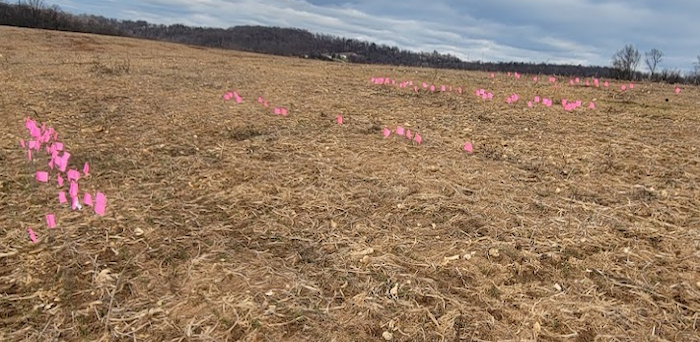
Winter King, Groff’s selectively bred variety of hairy vetch, flagged for replanting.
This method of developing a custom variety of cover crop requires extensive time and patience outside of a laboratory setting, but the process of flagging crops and replanting the best ones across seasons is a straightforward solution to each farm’s unique environmental, soil and planting needs.
2. Microbe Teas
The use of microbes to enhance soil and crop health has taken off in recent years, according to Groff.
“Those of us who have been in this space of regenerative agriculture are really taking a good look at it,” Groff says.
Two common practices are the Johnson-Su composting method and the Korean natural farming method, which both use microorganisms to produce rich, fertile soil without the use of synthetic fertilizers. However, what intrigues Groff the most is the Indigenous Microorganism Solution (IMOS) from Guardian Grains.
In this system, farmers take soil from an undisturbed area on their land in order to harvest the microorganisms that are naturally present and make what Groff calls a tea. This tea is then spread onto cover crop seeds before planting, allowing the natural reintroduction of native microbes to a farmer’s soil.
“We’re able to basically rev up our soils from existing microbes that we have essentially killed by our farming practices over the years,” Groff says. “We can effectively reduce or even eliminate fertilizer if you do this long enough and increase nutrient density.”
Groff emphasizes that cover crops and soil health are the key to a more nutrient-dense crop, whether for cattle or human consumption. The more biologically active the soil is, the more fertility and nitrogen that cover crops can then provide to the soil — and cash crops — in return. Groff says the IMOS system and other microbial reintroduction practices prove that the idea is catching on and that there is a market for it.
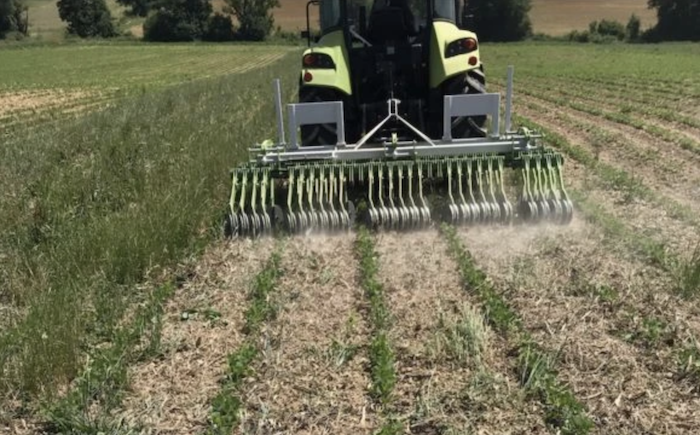
The Roll-N-Sem in action, a cover crop roller from France with the flexibility to move with the terrain and the customization necessary to flatten cover crops in between rows of growing cash crops.
3. New Cover Crop Roller Design
Though it hasn’t been adopted in the U.S. yet, a cover crop roller from France called Roll-N-Sem has Groff’s attention. Unlike traditional roller crimpers, the Roll-N-Sem does not crimp stems. Instead, it’s fitted with flat-edged plates that are 3/16 inch wide. The plates drag across the cover crop and scrape the length of the stem. The end result is the same as crimping in that the damage to the stem facilitates drying down of the cover crop.
Another unique feature of the Roll-N-Sem is its flexible arms that allow the rollers to follow the terrain, rather than passing right over depressions and valleys in the soil. The customizable arm also allows farmers to remove certain rollers in order to flatten cover crops in between rows of growing cash crops.
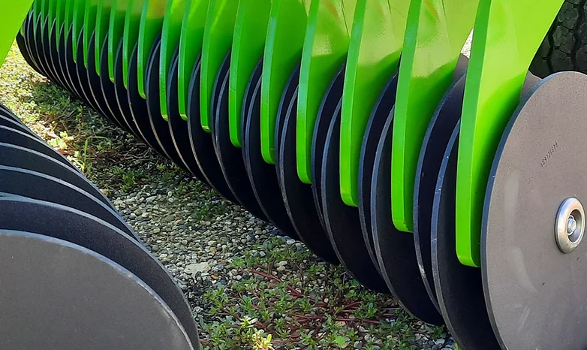
The plates of the Roll-N-Sem seen here are flat and do not crimp the stems of cover crops. Instead, it scrapes and flattens them, facilitating dry down.
While rolling cover crops without herbicide isn’t always realistic, Groff says rolling can dramatically reduce the amount of herbicide necessary to terminate cover crops.
4. Natural Herbicides
As for herbicides, Groff is trialing Harpe, a naturally derived herbicide made with mint. He says it’s similar to using 1.5 pints of Gramoxone per acre. After rolling down and spraying his own cover crops with Harpe, he saw a notable burn 24 hours after application.
“A little herbicide goes a long way, and maybe I can get away from RoundUp. So pretty exciting,” Groff says.
Though this product is not set to be available until 2025, Groff is hopeful that it will be approved to mix with other synthetic products to help control herbicide-resistant weeds.
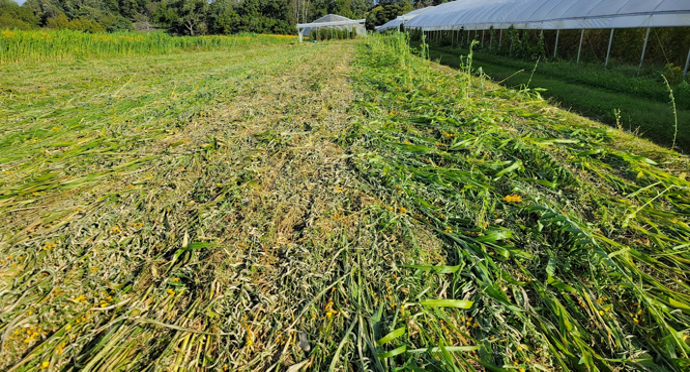
The burned row of cover crop seen on the left is 24 hours after rolling and spraying with Harpe, a naturally derived herbicide. In comparison, the row to the right has only been rolled down and no herbicide applied.
“Spraying herbicide on and then rolling the cover crop is going to be a one-two punch and may be a game changer on how we manage some of our cover crops,” Groff says.
Harpe is not the only naturally produced herbicide on the market or in development, according to Groff.
“Stay tuned, and have patience,” he says. “I think we have an opportunity here.”
5. Closing Wheel Deflectors
When planting into cover crops, wrapping is a frustration among no-tillers, especially those who use spiked closing wheels.
“It’s a beautiful day, you’re planting, and your wheels clog up,” Groff says. “It's beyond frustrating. So, what do we do? Do we give up cover crops? No, we figure it out.”
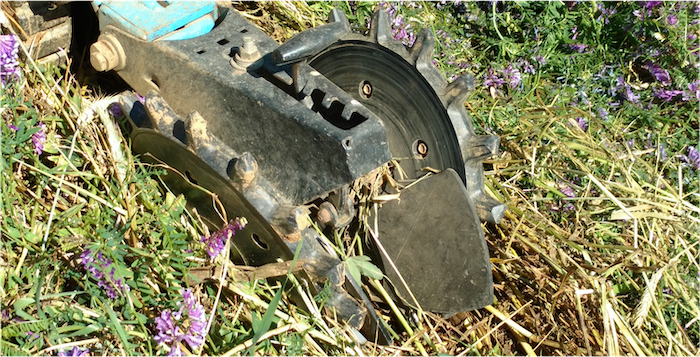
Groff’s closing wheel deflectors prevent cover crops from wrapping around the spokes of closing wheels.
To mitigate this issue, Groff recommends using deflectors, also called trash guards, on the planter to keep the cover crop from wrapping. Though there are multiple companies making these products, Groff uses Yetter’s deflectors and angle pitch closing wheels. They have been sold across the world for several years but are only just becoming available in the U.S.
These closing wheels allow farmers to adjust the pitch of the spokes to avoid packing the soil, which isn’t needed in a no-till situation. This customizable closing wheel makes it easier to adjust the angle based on the conditions of each field’s soil. Groff says that farmers may not even need spoked wheels with this product.
6. Farm to Table
As Groff’s focus has turned toward spreading the soil heath message to consumers, he says farmers are not the only ones who care about regenerative agriculture. There are people all the way from local restaurants to widely known chefs — such as Dan Barber, author of Third Plate, a book about sustainable food production systems — who are using cover crops in their dishes and sourcing food from their own backyard.
“So in the context of cover crops, we just constantly have to remind ourselves that the secret to doing all this stuff I’m talking about here is to concentrate on the biology of the soil,” Groff says. “Biology is very elusive. It’s alive. It’s hard to measure. It’s hard to put dollars and cents to it.”
He emphasizes making nature work for farmers rather than against them, and the way to do that is through regenerative agriculture. Though there’s experimentation, time and patience required on the front end, the payoff is nutrient-rich soil, better food and a healthier world, according to Groff.
“We have all these cover crop strategies that we can implement to have healthy soil and provide healthy food,” he says. “We have to reach out to our kids or our grandkids in my case. It is our future. And if they understand this, it’s going to help drive the demand from the consumer side.”
Related Content
[Podcast] Less Fertilizer Needed for Vegetables When Grown with Cover Crops
Groff: Hemp Will Be a Viable Cash Crop in Next Decade
[Podcast] Untreated Cover Crop Seed Can Reduce Pest Pressure





Post a comment
Report Abusive Comment